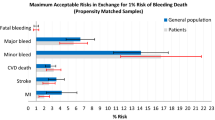Abstract
New anticoagulant drugs alternative to vitamin K antagonists are currently under clinical evaluation. Patient’s preferences should be considered in the development of new therapeutic strategies. Our study aim was to elicit patient preferences, and estimate their willingness to pay for the different treatment options. A Discrete Choice Experiment was administered to patients consecutively attending an anticoagulation clinic, either on stable oral anticoagulant therapy, or during their first visit at the time of starting therapy. Six treatment characteristics were analysed: route and number of medication administrations, frequency of monitoring, risk of some minor bleeding, the amount of attention required for drug/food interactions, requirement for dose adjustment, and out-of-pocket treatment cost. Relationships between patient’s preferences and their characteristics were analysed. 255 patients participated (55 % men, with a mean age 64 years; 35.7 % on stable therapy). A statistically significant importance was attributed to all but two characteristics (the amount of attention required for interaction with other drugs/food and for dose adjustment.) Monthly patient willingness to pay was € 79 for tablets versus injections; € 41 for once-daily versus twice-daily tablets, € 25 for drugs without risk of minor bleeding events and € 20 for once-monthly versus twice-monthly monitoring. Patients on stable therapy considered more important the amount of attention required for drug/food interactions than did the starters. Younger or working patients considered the reduction of monitoring frequency more important than did the older or not working patients (retired, housewives). This study elicited preferences from patients on oral anticoagulant therapy with a simple and well established method, which allows to obtain information warranted for planning optimal healthcare.
Similar content being viewed by others
References
Ansell J, Hirsh J, Poller L, Bussey H, Jacobson A, Hylek E (2004) The pharmacology and management of the vitamin K antagonists. The seventh ACCP conference on antithrombotic and thrombolytic therapy. Chest 126:204S–233S
Sullivan PW, Arant TW, Ellis SL, Ulrich H (2006) The cost effectiveness of anticoagulation management services for patients with atrial fibrillation and at high risk of stroke in the US. Pharmacoeconomics 24(10):1021–1033
Weitz JI, Bates SM (2005) New anticoagulants. J Thromb Haemost 3:1843–1853
Di Nisio M, Middeldorp S, Büller HR (2005) Direct thrombin inhibitors. N Engl J Med 353:1028–1040
Mannucci PM, Franchini M (2011) Old and new anticoagulant drugs: a minireview. Ann Med 43:116–123
Mannucci PM, Nobili A, Garattini S (2012) New drugs for thromboprophylaxis in atrial fibrillation. Eur J Intern Med 23:1–5
Ryan M (1999) A role for conjoint analysis in technology assessment in health care? Int J Technol Assess Health Care 15(3):443–457
Ryan M, Gerard K, Amaya–Amaya M (2008) Using discrete choice experiments to value health and health care. Springer, Heidelberg
Louvier JJ, Hensher DA, Swait JD (2000) State choice methods: analysis and applications. Cambridge University Press, New York
Bland M (1995) An introduction to medical statistics. Oxford University Press, England
Smith R (2004) Abusing patients by denying them choice. BMJ 328:7
Nobili A, Garattini S, Mannucci PM (2011) Multiple diseases and polypharmacy in the elderly: challenges for the internist of the third millennium. J Comorb 1:28–44
Acknowledgments
This study was funded by the institutional allowances of the authors.
Conflict of interest
None.
Author information
Authors and Affiliations
Corresponding author
Rights and permissions
About this article
Cite this article
Moia, M., Mantovani, L.G., Carpenedo, M. et al. Patient preferences and willingness to pay for different options of anticoagulant therapy. Intern Emerg Med 8, 237–243 (2013). https://doi.org/10.1007/s11739-012-0844-3
Received:
Accepted:
Published:
Issue Date:
DOI: https://doi.org/10.1007/s11739-012-0844-3




